SOUTHERN BELLES—WAIPARA WEST (WW) / THE BONE LINE, WAIPARA, CANTERBURY.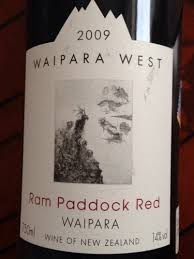
This posting is mostly aimed at the New Zealand and Australian readers in that it discusses the new presentation for the two countries down under and not the UK presentation.
The wines that we tasted are available in UK under the traditional ‘WAIPARA WEST’ labels which we have worked with since the start of the shop and are available from Paul Tutton (See below) ‘WATERLOO WINE COMPANY. Each of the labels are created by Paul’s wife Olga Sienko and are from larger originals some of which are on display at the Waterloo Wine shop in Lant Street, London SE1
 Brian first worked as General Manager for one of Paul’s companies back in the late 1970’s when Old Chelsea Wines was his main wine company and Paul’s principal activity was his ‘Tutton’s Restaurant’ in the centre of the newly re-worked Covent Garden. Soon after, Paul, his wife, sister and brother in law set up Waipara West vineyard, it had a wine style we immediately liked and so, when we got the shop, we were very pleased to sell them. Although we have kept contact with Paul over the years through the wine from Waipara West this was the first time that we have ever had the chance to see the vineyard and meet the people who made those wines we first enjoyed all those years ago.
Brian first worked as General Manager for one of Paul’s companies back in the late 1970’s when Old Chelsea Wines was his main wine company and Paul’s principal activity was his ‘Tutton’s Restaurant’ in the centre of the newly re-worked Covent Garden. Soon after, Paul, his wife, sister and brother in law set up Waipara West vineyard, it had a wine style we immediately liked and so, when we got the shop, we were very pleased to sell them. Although we have kept contact with Paul over the years through the wine from Waipara West this was the first time that we have ever had the chance to see the vineyard and meet the people who made those wines we first enjoyed all those years ago.
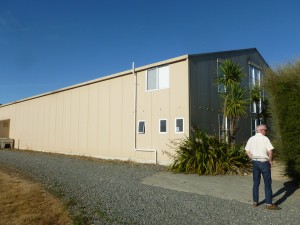 As you will know from the previous posting, the journey up from Central Otago was both interesting and not without its frustrations, however the arrival was worth all the efforts! The morning was lovely and sunny and heralded a perfect early autumn day, ideal for walking the vineyards and valleys. The winery is a modern building but looked a bit deserted as we arrived at 8.30 am, however appearances were deceptive as Lindsay had dropped off Viv and gone to collect consultant winemaker Jeff Sinnot.
As you will know from the previous posting, the journey up from Central Otago was both interesting and not without its frustrations, however the arrival was worth all the efforts! The morning was lovely and sunny and heralded a perfect early autumn day, ideal for walking the vineyards and valleys. The winery is a modern building but looked a bit deserted as we arrived at 8.30 am, however appearances were deceptive as Lindsay had dropped off Viv and gone to collect consultant winemaker Jeff Sinnot.
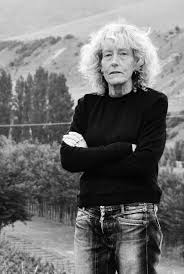 Vic Tutton (see right) is Pauls sister, and Shaun, (the assistant winemaker), were in fact on site in the winery and we were soon joined by Jeff and Vic’s husband Lindsay Hill who was to show us around the vineyard and Waipara valley. Jeff and Vic had long since been booked in to a Wine Symposium in Christchurch on ‘Wine Faults’, a subject that is close to all wine makers hearts. To this day I have no idea whether they were attending it or speaking at it!
Vic Tutton (see right) is Pauls sister, and Shaun, (the assistant winemaker), were in fact on site in the winery and we were soon joined by Jeff and Vic’s husband Lindsay Hill who was to show us around the vineyard and Waipara valley. Jeff and Vic had long since been booked in to a Wine Symposium in Christchurch on ‘Wine Faults’, a subject that is close to all wine makers hearts. To this day I have no idea whether they were attending it or speaking at it!
 Jeff has a very distinguished past and present, having graduated with Honours from Roseworthy he has worked as winemaker both in Australia and New Zealand for such great names as Isabel Estate and Amisfield, we imported Konrad, Toi-Toi and not forgetting his own family vineyards Ostler Vineyards. Since 2012 he has been deeply involved in the subtle way in which the style of WW wines are being adjusted to meet modern palates and requirements. In many instances it is a case of, in Jeff’s words, “letting the vineyard make the style rather than the winemaker”.
Jeff has a very distinguished past and present, having graduated with Honours from Roseworthy he has worked as winemaker both in Australia and New Zealand for such great names as Isabel Estate and Amisfield, we imported Konrad, Toi-Toi and not forgetting his own family vineyards Ostler Vineyards. Since 2012 he has been deeply involved in the subtle way in which the style of WW wines are being adjusted to meet modern palates and requirements. In many instances it is a case of, in Jeff’s words, “letting the vineyard make the style rather than the winemaker”.
All the wine is made on site, from fruit grown on site, using s/steel and oak fermentation and matured in the mix of new and old barriques of which there are 225 in the winery. White varieties grown are Chardonnay, Riesling and Sauvignon Blanc and red varieties are Cab Sauvignon, Cabernet Franc, Pinot Noir, Merlot and a small amount of Syrah. The vines generally are now maturing having been mostly planted in 1989/1993 but including the newer plantings suggested by Jeff the average is now 20years.
The vineyard is part of a long valley on a number of terraces all of which were formed in prehistoric times and which are now across a geological fault that has moved at least twice and revealed many unique fossils, it is a stunning open book of history going back millions of years. The result as far as Waipara West is concerned is a large variety of soils and microclimates within the area of the vineyard. Some of the soils are so hostile that even the phylloxera grub is put off burrowing through it, so that some of the vines on the estate are on original European briars. Whilst Waipara West in its UK form has succeeded in UK and Europe it has not achieved its potential down under and so it was decided three years ago to find a more terroir based image and so ‘The Bone’ Line was born and launched last November (2014) for the Australasian market.
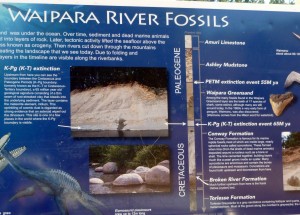 Called the Bone Line as this relates directly to the unique archaeological site that is the valley in which the vineyard is situated! The theory that the dinosaurs and many other species were made extinct by the arrival of a meteor on earth is now widely accepted and partially evidenced by the existence of a layer of Iridium, a base element, not widely found on earth except at a single period that coincides with the disappearance of so many species, called the K-T Event. This layer shows 160 times more Iridium than at any other period in the earth’s history, and appears as a layer, a line, beneath which are found the fossilised bones of extinct species. The board erected by Canterbury Museum (see above) at the river crossing shows clearly the line in reality in the river cliffs at Waipara and demonstrates all the layers above and below it over several hundred million years! A great many of those fossils have been found in the Waipara River Valley beneath the line of Iridium, ‘The Bone Line’!
Called the Bone Line as this relates directly to the unique archaeological site that is the valley in which the vineyard is situated! The theory that the dinosaurs and many other species were made extinct by the arrival of a meteor on earth is now widely accepted and partially evidenced by the existence of a layer of Iridium, a base element, not widely found on earth except at a single period that coincides with the disappearance of so many species, called the K-T Event. This layer shows 160 times more Iridium than at any other period in the earth’s history, and appears as a layer, a line, beneath which are found the fossilised bones of extinct species. The board erected by Canterbury Museum (see above) at the river crossing shows clearly the line in reality in the river cliffs at Waipara and demonstrates all the layers above and below it over several hundred million years! A great many of those fossils have been found in the Waipara River Valley beneath the line of Iridium, ‘The Bone Line’!
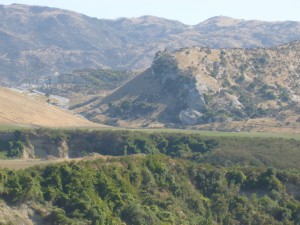 There is some discussion as to whether ley lines and tectonic plate lines have any connection, so for the moment, we will stick to tectonic plate lines. The Waipara Valley and River coincides with a major tectonic plate line where the Australian plate meets the Pacific plate, no wonder the recent earth quakes in Christchurch were so violent! So violent was the movement around the plate lines, millions of years ago, the resulting soil types are very varied within a few hundred yards, it is this factor that allows WW to grow so many grape varieties so successfully within such a relatively small estate.
There is some discussion as to whether ley lines and tectonic plate lines have any connection, so for the moment, we will stick to tectonic plate lines. The Waipara Valley and River coincides with a major tectonic plate line where the Australian plate meets the Pacific plate, no wonder the recent earth quakes in Christchurch were so violent! So violent was the movement around the plate lines, millions of years ago, the resulting soil types are very varied within a few hundred yards, it is this factor that allows WW to grow so many grape varieties so successfully within such a relatively small estate.
After the family bought the estate in 1989 they discovered that it had been an unsuccessful sheep farm owned by an ancestor, so the land was actually coming full circle, after further research they understood the layout as it was and were able to name the wines accordingly, hence ‘Terrace Red’ and ‘Ram Paddock Red’. This ability to relate to the past has extended to the ‘Bone Line’ range in that each of the varietals has its own fossil to relate to its terroirs origin, more details with each of the tasting notes.
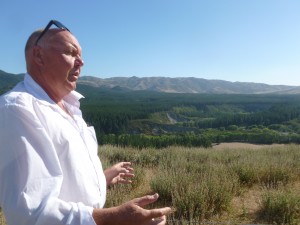 Lindsay is the Managing Partner, a role that brings together all the elements of the business, the partners, the winemaking and viticulture. He is assisted in the practical elements by Shaun who is Assistant Winemaker and very knowledgeable about the winemaking as well as making a considerable contribution to the development of the new label, and Gary Quinn who is the Viticulturist and takes this multifaceted vineyard, its micro-climates and varied soils and draws them all together. Lindsay began his career in Horticulture and set up a landscaping company and then brought that experience to the table when he, Paul and Vic set up the vineyard.
Lindsay is the Managing Partner, a role that brings together all the elements of the business, the partners, the winemaking and viticulture. He is assisted in the practical elements by Shaun who is Assistant Winemaker and very knowledgeable about the winemaking as well as making a considerable contribution to the development of the new label, and Gary Quinn who is the Viticulturist and takes this multifaceted vineyard, its micro-climates and varied soils and draws them all together. Lindsay began his career in Horticulture and set up a landscaping company and then brought that experience to the table when he, Paul and Vic set up the vineyard.
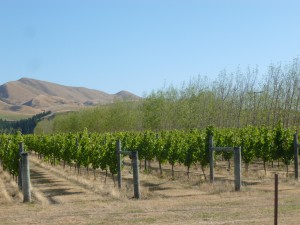 It was Lyndsay who piled us into his 4×4 and set off on a detailed tour of the vineyards and surrounding valley (See left), with him pointing out a great many of the local volcanic points of interest as well as places where many of the fossils were found. It is here that was home to one of the oldest flying seabirds, bones of the previously unknown species were found in 2009 in Waipara by Leigh Love, an amateur fossil collector from the region and friend of the team at WW. In fact the fossils shown on the ‘Bone Line’ range are by courtesy of Leigh Love, this underlines how very special this area is and that is not only for fossils but for wines as well!
It was Lyndsay who piled us into his 4×4 and set off on a detailed tour of the vineyards and surrounding valley (See left), with him pointing out a great many of the local volcanic points of interest as well as places where many of the fossils were found. It is here that was home to one of the oldest flying seabirds, bones of the previously unknown species were found in 2009 in Waipara by Leigh Love, an amateur fossil collector from the region and friend of the team at WW. In fact the fossils shown on the ‘Bone Line’ range are by courtesy of Leigh Love, this underlines how very special this area is and that is not only for fossils but for wines as well!
We set out on the ‘top road’ which runs along from the winery and back into town, on this level are the flatter parts of the vineyard with sloping hills to the south, here the air moves and so usually prevents frost. In 2015 they had the first serious frost problems in 25yrs., a freak frost that lasted nearly a week in the middle of bud burst has destroyed a large part of the current crop of Chardonnay and Pinot Noir. The estate is about 220ha and the producing vineyard covers nearly 30ha of it on at least four levels of terraces made up of such varied soils as river gravels with silt & limestone to alluvial loams over gravels. It is this variety that allows such a varied collection of vines to prosper and produce such great fruit.
The other great contribution to its versatility is the fact that each of the blocks differs in height and aspect with the river terraces being partially encompassed by cliffs. There is a prevailing NW wind which both assists, in that the movement of air keeps the vineyard largely free of disease, and is a problem in that it desiccates the vines as occasionally it blows at (yes) 170MPH, add this to the thermals that are created in the summer by the heat rising up the cliffs on each site of the valley and you begin to understand the complexity of farming this land.
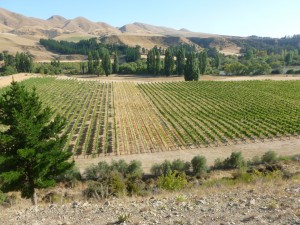 The terraces protect the red vines from too much wind, on the second level (see right) a mixed vineyard of Cabernet Franc to the left, new Syrah in the middle and Cabernet Sauvignon to the right! The whole is already 145’ ASL and less than 20km. from the coast, a sign of the level of violent volcanic activity millions of years ago.
The terraces protect the red vines from too much wind, on the second level (see right) a mixed vineyard of Cabernet Franc to the left, new Syrah in the middle and Cabernet Sauvignon to the right! The whole is already 145’ ASL and less than 20km. from the coast, a sign of the level of violent volcanic activity millions of years ago.
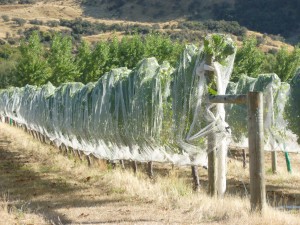 Again we saw the nets protecting the vines from birds, indeed this was the first time we had seen not only nets but – so devious are the little chaps – that the nets have to be clipped together at the bottom to stop birds going in underneath – having sussed that if you cannot get at the grapes one way, try another! This was a feature that we saw more and more, nets being used to protect the vines and fruit trees as we moved up the Island. Like most of the vineyards in New Zealand, especially in years like 2015 it is essential to irrigate; otherwise the vines simply dry out and die, especially with the prevailing winds scouring the land!
Again we saw the nets protecting the vines from birds, indeed this was the first time we had seen not only nets but – so devious are the little chaps – that the nets have to be clipped together at the bottom to stop birds going in underneath – having sussed that if you cannot get at the grapes one way, try another! This was a feature that we saw more and more, nets being used to protect the vines and fruit trees as we moved up the Island. Like most of the vineyards in New Zealand, especially in years like 2015 it is essential to irrigate; otherwise the vines simply dry out and die, especially with the prevailing winds scouring the land!
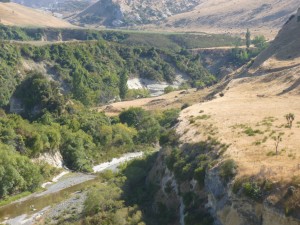 The source of the water for WW is the Waipara River which flows through the estate (see left), water is pumped out into reservoirs (see below) and then used to irrigate that level of terraces. You can see here, as well as in the red vines picture above, the use of tree lines as wind barriers, a subject that is becoming controversial in that the trees are draining the goodness from the soil to as much as three or four lines of vines either side. In fact WW are starting to take down many of them as it seems that the protection they give is outweighed by the loss of crop in the surrounding rows.
The source of the water for WW is the Waipara River which flows through the estate (see left), water is pumped out into reservoirs (see below) and then used to irrigate that level of terraces. You can see here, as well as in the red vines picture above, the use of tree lines as wind barriers, a subject that is becoming controversial in that the trees are draining the goodness from the soil to as much as three or four lines of vines either side. In fact WW are starting to take down many of them as it seems that the protection they give is outweighed by the loss of crop in the surrounding rows.
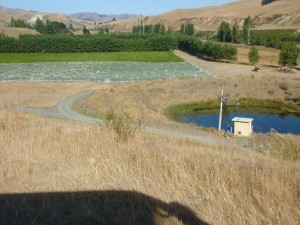 The right hand picture shows the lowest terrace known as the ‘Hell Block’, here the land is virtually pure gravel and as such the Riesling is very much at home on its European rootstock as the phylloxera grubs will not penetrate it. This is much the same scenario as in many German vineyards especially on the Mosel, and guess what they grow there!
The right hand picture shows the lowest terrace known as the ‘Hell Block’, here the land is virtually pure gravel and as such the Riesling is very much at home on its European rootstock as the phylloxera grubs will not penetrate it. This is much the same scenario as in many German vineyards especially on the Mosel, and guess what they grow there!
Many of the jobs that are covered by machine are done by hand here, the control of budding, green pruning, control of the canopy and finally all of the harvesting is done by hand, Lindsay estimates that the vineyard workers, permanent and temporary, pass through the vineyard lines about 11 times during the course of a full season. Jeff has changed some of the vineyard practises and adapted some of the vinification processes but it is as Lindsay says “our wines now reflect the terroir even more than they have, ever since we started the winery ”, from where I am sitting that has to be a very positive attitude!
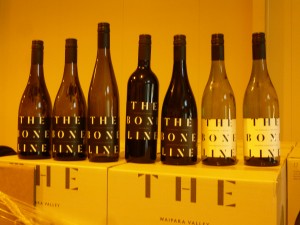 After an extensive tour of the area we went back to the winery and tasted the whole of the new ‘Bone Line’ range. So as not to reinvent the wheel, with each wine I have copied the technical data given to us by Lindsay from the Website and then shown below our own tasting note.
After an extensive tour of the area we went back to the winery and tasted the whole of the new ‘Bone Line’ range. So as not to reinvent the wheel, with each wine I have copied the technical data given to us by Lindsay from the Website and then shown below our own tasting note.
BARE BONES CHARDONNAY 2014:
“Given that Waipara is a homo-clime for Chablis and we also have limestone subsoil’s we feel this is a valid approach to a crisp, structured Chardonnay style. Parcels of fruit from 3 different clones, old vines selected for large berries. Destemmed, briefly skin contacted, then each clone fermented separately in tank with moderate solids to dryness. Aged on primary ferment lees without SO2 or Malo for 14 months with gentle stirring to enhance yeast autolysis and mouth feel. Bottled just after harvest 2014. A deliberate attempt at a pure Chardonnay made to emphasize subtle secondary varietal character, structure and texture”.
The first thing that strikes are the beautiful fresh aromas, hints of sherbet and clean exotic citric fruits, almost a tingle on the nose, a lot of minerality but little herbaceousness, however that is not what they want in this wine. The palate develops the citric quality with grapefruit notes and although it has a very clear acidity this is balanced off with fruit and minerality. The texture of the wine clearly has no oak but still has good firm mouthfeel and a hint of yeastiness and warmth on the finish. The fine long sharks tooth reflects its fine lines and what a great name, which again the wine reflects, nothing but the bare bones of good Chardonnay, it will drink really well with shellfish and even as an aperitif, or just on its own in summer, great!
SHARKSTONE CHARDONNAY 2013:
“Drawn from the oldest multi-clone, small berry vines on the property. Handpicked, whole bunch pressed with full solids to 20% new French oak, where it was fermented, matured, put through partial malolactic and rested on lees for 12 months”.
This has much softer aromas straight away than the Bare Bones, big rounded exotic fruit notes, much more leafy herbaceousness but without losing that citric freshness given to it by the acidity. The Chablis minerality Jeff noted in the Barebones is still here but now we are talking the style of Premier Cru with lovely subtle oak tones already well integrated into the fruit and citrus. The palate has a much fuller texture developing the oak and the leesy, yeasty qualities into a very harmonious whole. The acidity is citric again, more lemon than grapefruit this time, but with a clean although soft, presence that stops the heavier texture being in the slightest cloying, this lingers on the palate, clean lemon acidity and hints of oak. The fossil this time is a Shark Vertebrae, it is certainly true that this Chardonnay has a lot of spine! Lovely fish wine or a marriage in heaven with Roast Chicken.
SAUVIGNON BLANCE BONE LINE 2014:
“Grown alongside the Riesling vines in ‘Hellblock’, sharing the searing summer heat and cold Autumn nights. This is a very lively block with spring fed gravels allowing vine roots to express their unfettered character. Handpicked, destemmed, and given extended skin contact. Clear juice cool fermented in tank with selected yeast strains in order to extract its riotous nature. Riper fruit left on lees for the winter which adds nuances of yoghurt, linseed and fruit”.
Very pale in colour, the aromas at once have the fresh zingy sherbet feel of the unoaked Chardonnay but this time the aromas are pure S/B, Brian honed in on the gooseberry and the hint of cats pee, really apparent minerality which, given the gravel nature of the Hellblock soil, is hardly surprising! Linear in style with the same exotic passion fruit notes showing on both palate and nose, has great initial presence but the attack of fruit on the middle palate is notable, a lemon notes steals in on the finish which has wonderful acidity but enough palate texture for it not to be aggressive. Too many S/B’s especially from N/Z are too aggressive on the finish and leave the palate awash with astringent flavours but here, although it is long lasting there was a pleasant well balanced feel. Since then, I have found out that the vines are some of the oldest on the estate I guess that is the reason why!
RIVERBONE SAUVIGNON BLANC 2013:
“Grown and made with complexity in mind. Handpicked, whole bunch pressed direct to barrel. High solids ferment in new and seasoned French oak. Wine retained on lees with intermittent stirring for 8—10 months. No malolactic”.
When the oaked Sauvignon wines began to appear I was a bit dubious, but I have been well and truly converted, incidentally we found a couple of bottles of David Hohnen’s 1996 Te Koko in the cellar in December and the first one we tried was still just delicious! Back to the Riverbone, this we are told above is aimed at complexity and it achieves it in shedloads! The selection for this wine starts in the vineyards choosing the vines that are looking the best and reducing the canopy to get greater ripeness, picked when physiologically ripe but at 21-21.5Brix, they achieve clean but incredibly intense flavours. The whole bunch pressing introduces the stems into the process and the oak fermentation and maturing using a 50/50 new and used oak regime brings in further elements of tannin and extraction. Despite all this once again the first impression on the nose is one of zingy freshness, this is followed by surprisingly subtle oak notes and lots of fruit, shades of pineapple, grapefruit and the inevitable lychee are all there but what is surprising is the intensity of them. These characteristics follow through onto the palate which is full bodied and really does have so many facets that the over-used word ‘complex’ really applies! The oak is restrained but underlies the fruit and acidity and adds texture, each time you put the glass down and go back to it a new facet pops up! As you will have gathered we really loved this wine and it deserves to be recognised for the lovely example of Oaked Sauvignon Blanc that it is! I can’t wait to try this after three or four years!
HELLBLOCK REISLING 2013:
“Grown on a gravel river terrace in an amphitheatre that gets as hot as hell during summer. Picked while the skins are fresh without any sunburn to avoid phenolic development. Whole bunch pressed and enzyme settled before tank fermenting with neutral yeast. Ferment stopped while relatively sweet (37 g/L r.s.) but balanced with bright, laser like acidity and very low pH. No malolactic, bottled early to retain freshness”.
Always one of our favourites of the ‘Waipara West’ range the new approach has done nothing to change that point of view. Again a very light colour but that fools nobody – the intensity of the aromas is superb, minerality, just hints of diesel but not too much, a really floral aromatic with citrus fruit notes and hints of white fruit apple and pear. On the palate the explosion of flavour is just short of painful, Lindsay says that they “are not chasing the phenolic elements” my only comment to him was they don’t need to chase them they are not running away! Again they are using canopy control to achieve ripeness, the site alone with so much gravel gives the minerality and the result is something that Riesling drinkers should embrace. It has so much going on that again I look forward to seeing this wine in two or three years but that will be after I have drunk as much as I can while it is still young!
PINOT NOIR WAIMANU 2013:
“Mix of old Swiss and younger Dijon clones, handpicked and destemmed without crushing into small fermenters, with a small portion of whole bunch ferment. Ambient soak for 5–7 days then hand plunged through primary ferment and macerated on skins for a week post ferment, then pressed to 22% new Burgundian coopered French oak. Each block is fermented separately and matched to the most appropriate barrel maker after which it is aged on light lees, 100% malolactic & bottled with light filtration after 10 months”.
We know the older vintages of this wine very well and so it was interesting to see the newest release before it hits the UK. There is no doubt that there are two markets for Pinot Noir, the first when it is young and vibrant and the second matured and reeking of farmyard and black smoky raspberry. This shows elements of youth on the meniscus with violet notes, it is very lightly filtered so it has a hazy look to its light ruby colour. Again don’t let the lightness of the colour fool you, the intense nose has immediate black cherry, hints of smoky raspberry, some tobacco and spice from the oak and whole bunch pressing. The palate was rather closed at first (we opened and poured) but after twenty minutes in the glass the real character come through with huge intensity of fruit, balanced oak and spicy notes that kick in as the wine warms in the glass. There are some firm tannins which, if you have a palate like mine, are great now but for those of you who like it a bit softer I should give it a bit more time in bottle. There is no doubt that this is quality Pinot Noir and will stand up in the bottle for some time, combined with its approachability now that makes it an attractive buy!
IRIDIUM BORDEAUX BLEND 2013:
“Small berries are the mantra. Produced from our original plantings of Cabernet Sauvignon, Cabernet Franc and Merlot in roughly equal proportions. Hand picked, 100% de-stemmed without crushing and ambient soaked for 5—7 days. Hand plunged through primary ferment and macerated on skins for 2–3 weeks post ferment. Pressed to 25% new Bordeaux coopered French oak and matured for 14 months. 100% Malolactic. Bottled with light filtration in October 2014. A wine made through perseverance and coaxing in both vineyard and winery”.
In its WW guise as ‘Ram Paddock Red’ this has long been my favourite wine of all and not only because it has the 33% of Cabernet Franc but because the blend works so well and it ages superbly well. I know that Paul still had some 1999, I must ask him when we get back if there is still any available! The brief summary of the wine maker on the label describing this wine and its name is just so to the point and as follows; “rare metal — purple magenta — sea breeze —cabernet sauvage — merlot plum — franc spice”. Again lighter in colour than one might expect from three big varieties such as these but again don’t be fooled this is no weakling as the aromas soon tell you. For me the front line is the gunsmoke of the Franc, its distinctive lead pencil shavings incorporating the wood element is clear, and the final contribution of the Franc is the tell-tale Palma violet note! On top of this complexity there is the raw blackcurrant fruit of the Cabernet and the Victoria plum of the Merlot, the oak spice hints of dark chocolate and anise are all part of this multi-faceted wine and already well integrated. The tannins on the palate are firm and evident but in no way harsh, the fruit is forward and plentiful in its many facets and the time in oak has given the palate feel fullness and texture, all of which is carried through to long lasting clean finish. The acidity holds the wine fruit clean and fresh on the finish, superb now but will just get better and better for a long time I cannot wait to add some of this to our personal cellar as soon as it is available. You probably gathered we really, really like this one!
As a footnote, knowing Anita’s sweet tooth, we took advantage of being in the cellars to take her some of the two Late Harvest wines that have been produced as ‘one-offs’ a Riesling in 2011 and a Chardonnay in 2009. Only produced in 37.5cl or 50cl bottles and in very small quantities these are both little gems! We have tasted both wines from London stock and again with the local wine merchants when we got back to Matarangi and both wines were very well accepted.
WAIPARA WEST LATE HAVEST CHARDONNAY 2009: Zingy green straw colour quite deep the aromas are again complex with creamy aroma of honeysuckle, orange blossom and pineapple, the palate has a blanked harmony of sweetness and acidity but with a full textured palate accompanied by flavours of dried fig caramelized banana and melons. It finishes long with tropical fruit and zest.
WAIPARA WEST LATE HAVEST RIESLING 2011: This has a lighter colour than we expected but all the power is still the immediately on the nose there are the wonderful deep floral notes of peony and chrysanthemum balanced by zesty citrus and a complex mix of honey, bees wax and pineapple. A weighty, sweet and rich palate with background diesel notes starting to appear with bottle age firm acid that slices through the intense sweetness and continue into a long fruity balanced finish.
It has taken me a long time to write this up as it is necessary when going to print to ensure that all the facts are correct, this winery is drawing on the land’s million year history to describe the character of the wines it is producing now and that deserves reporting correctly. We are so pleased to see that the winery is working so well and that it is adapting to modern conditions without spoiling the character of the wines in fact in many ways improving them.
